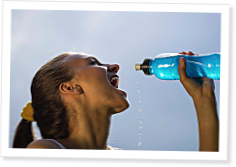
For almost 50 years, Gatorade’s marketing machine has been working to make you thirsty.
You can lead a man to water, but you can’t make him drink. Add sugar, salt, artificial flavors and a good story, and he’ll drink himself to death.
Since the early 1960s, sports-drink companies have worked to sell as many beverages as possible, and now the toughest market segment—people who just aren’t thirsty—has become the target thanks to clever advertising and sponsored research.
Gatorade created the “sports beverage” category and continues to dominate even though its marketing claims contradict scientific evidence, as shown in a document from the California Center for Public Health Advocacy.
Gatorade’s benefits have been hyped by owners of the formula, beginning with Stokely-Van Camp Inc.’s assertion that Gatorade was absorbed by the body “twelve times faster than water,” which was later discredited by its next owner, Quaker Oats. Quaker, already adept at using “research” as a marketing tool, founded the Gatorade Sports Science Institute (GSSI) in 1988. A year later, Gatorade sponsored the American College of Sports Medicine (ACSM), which in 1996 produced research supporting maximal intake of fluid—especially palatable fluids containing carbohydrates—even before an exerciser became thirsty.
Gatorade’s marketing aside, experts are aware that hydration is actually very simple.
“We have a 300 million year developed system that tells you with exquisite accuracy how much you need to drink and when you need to drink. It’s called thirst,” hydration expert Dr. Timothy Noakes wrote in “Waterlogged: The Serious Problem of Overhydration in Endurance Sports.”
Noakes is right, but sports-drink companies have somehow convinced us to drink when we’re not thirsty.
No comments:
Post a Comment